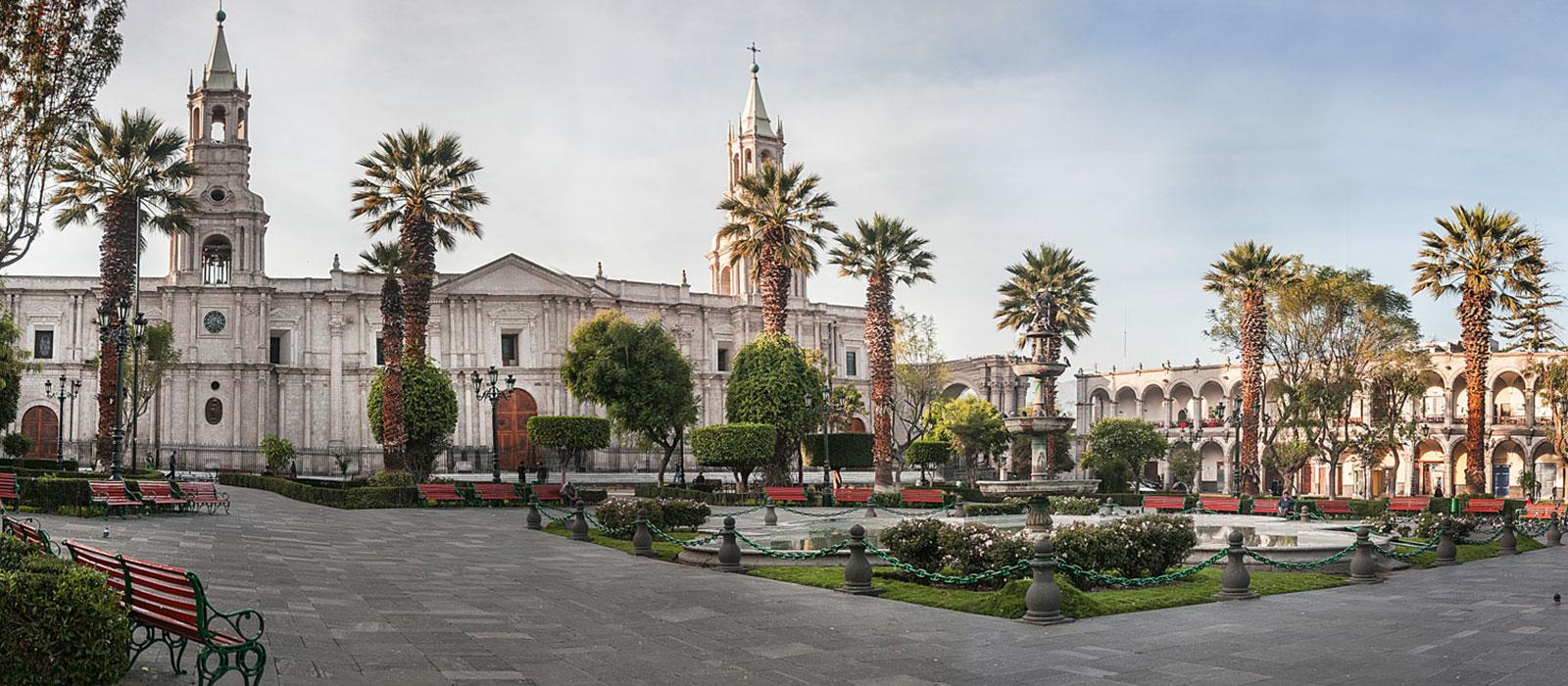
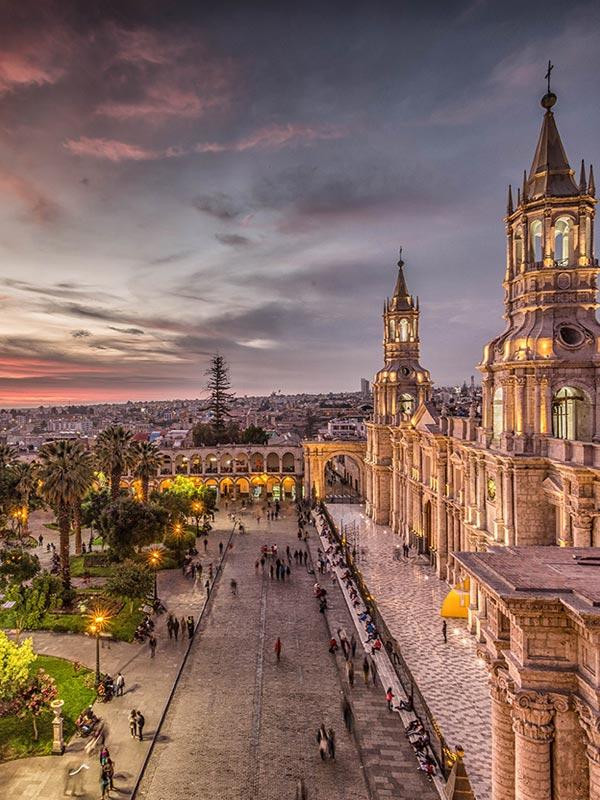
One of the largest cities in Peru, Arequipa boasts striking colonial architecture fashioned from volcanic sillar rock. As a result of the stone’s chalky hue, Arequipa has become known as the ‘White City’, or ‘Ciudad Blanca’. The historic center, which encompasses countless sprawling courtyards and intricate Baroque facades, is recognized as a UNESCO Heritage Site. Set among the exquisite arches of the Plaza de Armas, the Basilica Cathedral is one of Peru’s hidden gems.
Those local to Arequipa, known as Arequipeños, are immensely proud of their unique cultural heritage. The city is particularly renowned for its delectable culinary specialities. Visitors can expect to eat their way around town, stopping at traditional picanterías to sample dishes made from local ingredients.
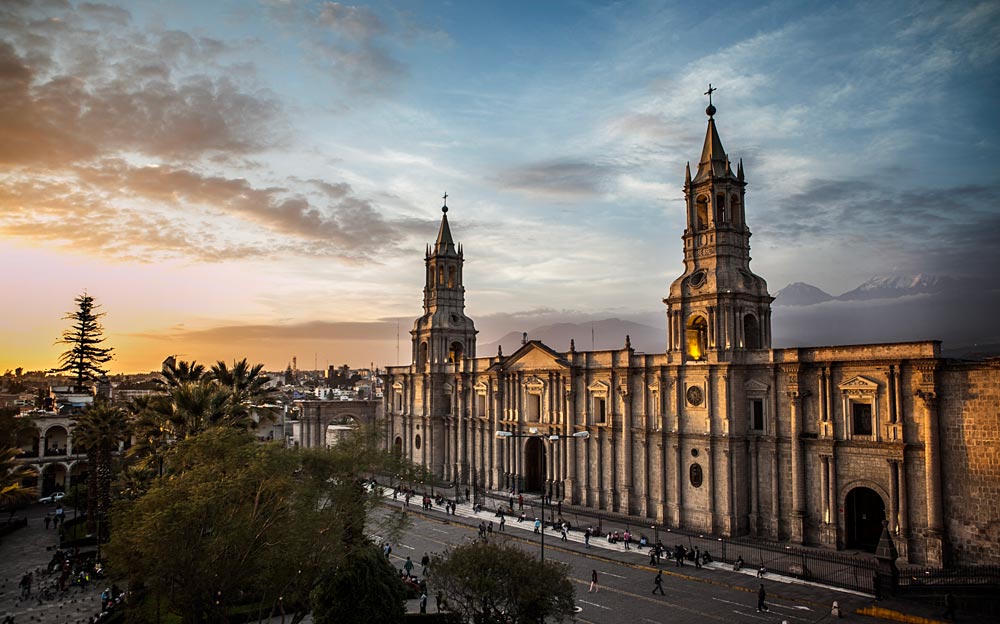
Moreover, Arequipa’s surroundings are as much of a draw as the city itself. Located close to one of the world’s deepest canyons, Colca, travelers flock to the region to revel in nature. There are hiking trails aplenty, as well as opportunities to glimpse vicuñas at the Salinas y Agua Blanca National Reserve. Whether visiting the urban area or the neighboring countryside, Arequipa offers engaging cultural and leisure activities to suit all.
Located in the south of Peru, Arequipa is surrounded by lush valleys. Streams from nearby mountain peaks help to irrigate the region’s green fields. Over time, the Ocoña and Majes rivers have also eroded the volcanic rock to create deep canyons. Three imposing volcanoes emerge above the plateaus and flank the city. Misti, the tallest of the three with its symmetrical, snow-capped peak has become symbolic of Arequipa. It even features on the region\'s flag.
Arequipa is the second largest city in Peru, behind Lima. It has an urban population of around 1 million inhabitants.
Arequipa is the perfect intermediate stop after Lima and before heading to higher elevations. Other destinations in the Andes, such as Cusco and Lake Titicaca, are at a much higher elevation. Arequipa is located at 7,700 ft (2,340 m) — 3,000 ft (1,000 m) less than Cusco or Puno. Few travelers experience altitude sickness here, and visitors can take time to acclimate if coming from sea level.
Be aware that the road between Arequipa and Colca Canyon reaches elevations of 13,100 ft (4,000 m). You will notice the higher elevation if you try any strenuous activity, such as hiking. Chivay and other Colca Canyon villages are at about the same elevation as Cusco, 11,150 ft (3,400 m).

The Arequipa region is situated on the tip of the Atacama Desert. Its climate is thus characterized by year-round sunshine and relatively low rainfall. Elevations vary from 7,000 ft in the city, to 20,000 ft and above in the surrounding canyons. When traversing these highlands, visitors can expect warm days and significantly cooler nights. High winds are also common in more mountainous areas.
From April to November
Dry season brings abundant sunshine during the day, but colder nights. Arequipa experiences an average of 300 sunny days a year. July is the coldest month and temperatures can drop to a chilly 41°F (5°C).
From December to March
Visitors can expect fair weather and sunshine throughout most of the wet season. Afternoons during this time are usually cloudy with light rainfall. February is the exception, when heavy rains are likely.
Like much of Peru, the city of Arequipa is a year round destination. The weather is most pleasant between April and November, when you will experience blue skies and sunshine. Sun protection is a must due to the high elevation, so make sure to bring a hat and sunscreen! If you want to miss the crowds, be aware that the peak time for tourists is from July to August.
If you are planning to visit Colca Canyon, plan your trip between May and November. You can expect little rainfall and mild temperatures. During these months, you will also have a good chance of glimpsing the magnificent Andean Condor. February should be avoided, as heavy rains can disrupt flights and limit hiking opportunities.

The Arequipa airport is called the Manuel Ballon International Airport (airport code: AQP). There are regular connecting flights to Arequipa from Lima, Juliaca (for Puno and Lake Titicaca), and Cusco. The airport is 5.5 miles (8 km) from the historic center of Arequipa.
Flight durations:
If arriving by air, an English-speaking representative from Inca Expert Travel will be waiting for you. Look for your representative outside the baggage claim area holding a sign with your name on it. If you arrange your own transportation, we recommend using one of the licensed taxi companies inside the airport.
Arequipa has 2 major bus stations, Terminal Terrestre and Terminal Terrapuerto. They are adjacent to one another, 2.4 miles (3.8 km) from the historic center. For long distance travel between Arequipa and Cusco, Puno, or Lima, the best option is a non-stop overnight route. The most reputable companies are Cruz del Sur, Oltursa, and Excluciva.
Popular inbound bus routes to Arequipa:
Popular outbound bus routes from Arequipa
It is possible to travel by train between Cusco, Puno, and Arequipa. The Belmond Andean Explorer train travels along one of the highest elevation train routes in the world. Starting in Cusco, the train journeys first to Puno (Lake Titicaca) and then to Arequipa on one and two-night trips. You can also do this journey in reverse, from Arequipa to Cusco.
There is no train route from Lima to Arequipa.
A three hour drive will take you 100 miles (160 km) from Arequipa to Chivay, the gateway to Colca Canyon. The most convenient option for most visitors is to book a Colca Canyon tour including private roundtrip van transport. This scenic journey passes through La Reserva Nacional de Salinas y Aguada Blanca. The protected reserve encompasses sprawling grass plains, volcanoes, lagoons, and wetlands. Along the way you may well spot herds of wild vicuña or a flamboyance of flamingos.
Car rental in Arequipa is not advised unless the driver has experience driving in Peru and on mountainous terrain.
Arequipa is among Peru’s most historical cities. Early inhabitants of the fertile lands surrounding modern day Arequipa settled around 900 AD. The Aymara indigenous people set up an agrarian economy in the lush valley. This pre-Inca civilization relied on the River Chili to irrigate agricultural terraces. Historians believe that the name Arequipa may be derived from the Aymara words \'ari’, meaning sharp, and ‘qhipaya’, meaning behind. The name would thus seem to describe the city’s location, behind El Misti’s angular peak.
In the 1400s the Inca Empire took control of these territories. It was around this time that Inca priests sacrificed “Juanita” atop Mount Ampato. The Ice Maiden remained mummified in glacial ice until the eruption of a neighbouring volcano in 1995.
In 1540, Garcí Manuel de Carbajal, a Spanish settler, refounded the city of Arequipa. The Fiesta de Arequipa, celebrated on August 15th, commemorates this event. Some 20,000 visitors descend on the city to watch colorful parades and firework displays.
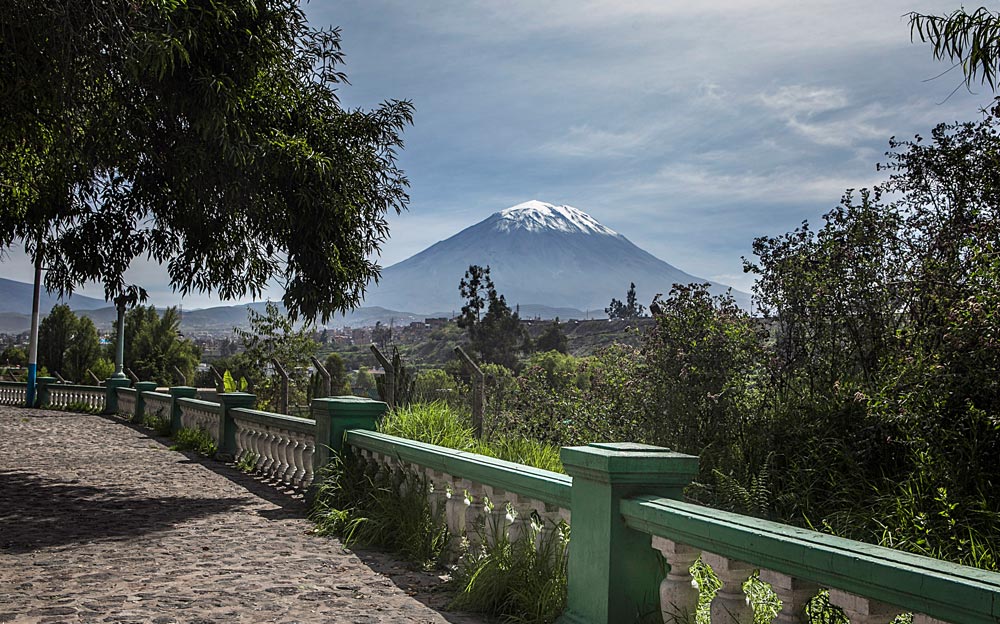
After the Spanish conquest, Arequipa developed as a religious and economic center. The city’s involvement in the silver trade allowed its citizens to grow wealthy. Affluent Arequipeños funded the construction of new buildings. Decorative churches, labyrinthine monasteries, and private casonas sprung up throughout the city. These sophisticated buildings were made from the abundant white sillar stone. Arequipa thus became known as Peru’s “White City.”
In the period after independence, Arequipa’s economic prosperity continued. From the late 1800s onwards, the city became home to an active political scene. Many Arequipeños led liberal uprisings and coups against the central government in Lima. This fed into a strong sense of regional identity that continues into the present.
The Historic Center of Arequipa earned UNESCO World Heritage Site recognition in 2000. The organization noted how the city\'s distinct character evolved as a result of natural consequences. Arequipa\'s robust, white rock buildings were constructed in response to earthquakes in the region. Although natural disasters levelled some buildings, repairs have always been made with the original design in mind.
Today, Arequipa is the second most populous city in Peru. It is also the most economically prosperous city in the southern Peruvian Andes.
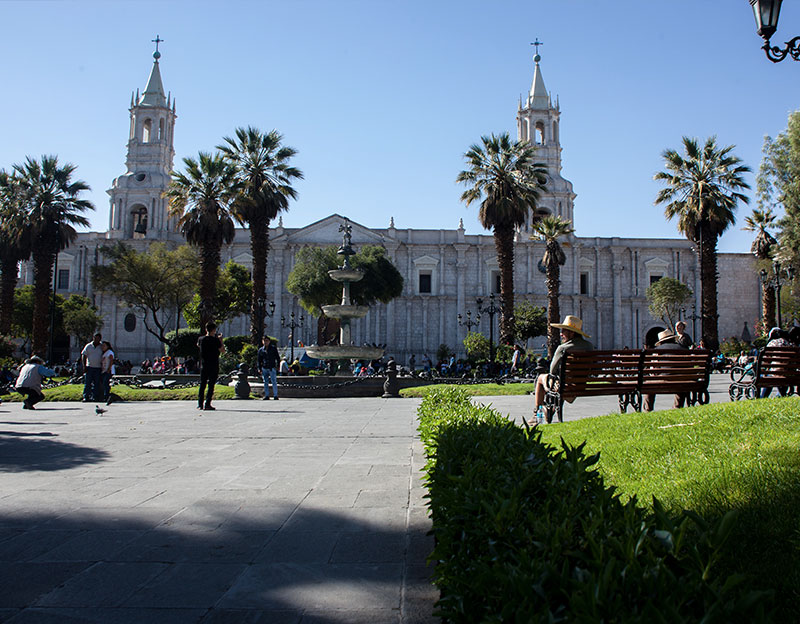
A visit to the beautiful Plaza de Armas tops the list of the best things to do in Arequipa. The Basilica Cathedral, the widest in Peru, is its eye-catching centerpiece. Built from sillar rock, the cathedral\'s two towers soar above the square. Another architectural delight is the Paseo Portal de San Agustin, an elegant, arched passageway that skirts the square. Make a wish at the Tuturutu fountain, or grab a snack from one of the cafes on the plaza’s edge.

The construction of the Basilica Cathedral (Catedral de Arequipa in Spanish) began in 1544. Although seismic tremors have periodically damaged the building, restoration works have managed to retain its grandeur. Stone masons most recently renovated the cathedral’s towers after an earthquake damaged them in 2001. Inside you will find an immense Belgian organ, the largest to ever cross the Atlantic Ocean. During your tour, climb to the cathedral\'s rooftop and appreciate the Plaza de Armas from the imposing bell towers.

Get lost in the charming passageways of Arequipa\'s Santa Catalina Monastery (Monasterio de Santa Catalina Arequipa in Spanish). Once home to 500 nuns, this sprawling convent is steeped in history. Brightly painted walls, engraved with the poetry of notable writers, provide the perfect backdrop for photos. Meander through elegant arches, cloisters, and cells while listening to your guide’s tales of the past.

The Iglesia de la Compañía de Jesús is located on the southeast corner of the Plaza de Armas. Although small in comparison to the neighbouring Arequipa Cathedral, it is definitely worth visiting. The church\'s stone entrance is intricately carved in the Spanish churrigueresque style. It also features a traditional gold-leaf altar and contrasting Andean murals.

Pay a visit to this archaeological museum, home to Juanita, the famous Ice Maiden Mummy. In the 1450s Inca priests sacrificed Juanita in an attempt to placate the gods in return for water. Anthropologist Johan Reinhard discovered her remains atop Mount Ampato in 1995. University students versed in local history lead tours of the museum in English, Spanish, and French. Between January and April, bioarchaeologists remove Juanita’s remains and place them in deep freeze for conservation purposes.

Transport yourself to Arequipa’s golden age with a visit to an 18th century mansion. This casona is named after the mulberry tree (‘arbol de moras’) in its courtyard. The oldest existing Baroque building in the city, its intricate facade features various Andean animals, such as the puma. Marvel at antique furnishings, alpaca rugs, and a collection of religious paintings.

Venture a small way out of the center to enjoy the views at Mirador Yanahuara. Located in a neighborhood bearing the same name, this viewpoint sits next to the Baroque San Juan de Yanahuara church. Use the terrace’s white stone arches as frames for photos of the historic town and the Misti volcano beyond.

Enjoy a mix of local and international art at this charming museum. Housed in a restored casona dating back to the 1540s, the collection features 9 permanent and 4 temporary exhibitions. Works include paintings in a variety of mediums, as well as sculptures and cartoons. You will also find black and white photographs by Carlos and Miguel Vargas. Born in Arequipa in the 1880s, the brothers are famed for fabricating their own camera at the age of 13.
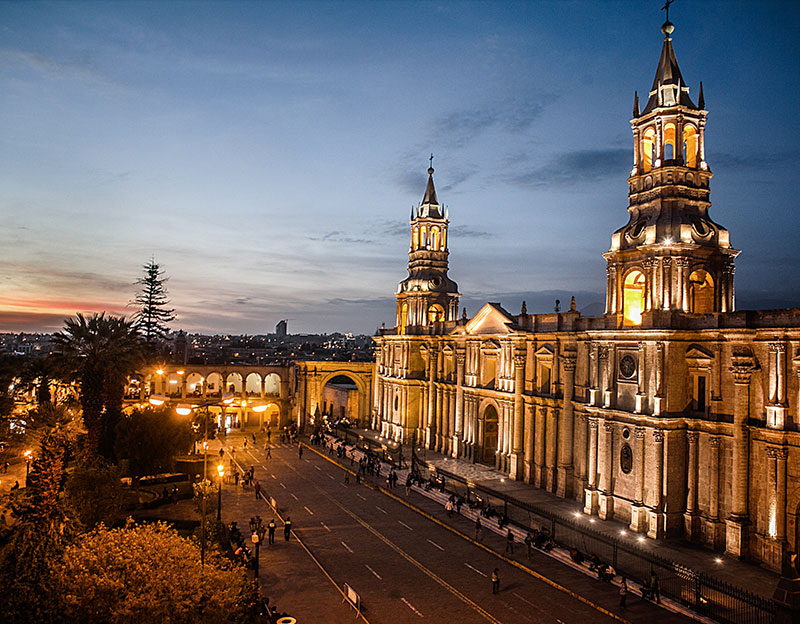
Admire the radiant stone architecture of monumental buildings throughout the UNESCO protected center. Historic Arequipa tours often visit the Plaza de Armas, the Basilica Cathedral, and the nearby San Camilo Market. Other stops include the Santa Catalina Monastery and Yanahuara viewpoint. The Ruta del Sillar, a striking sillar quarry in the Cerro Colorado district, may also be added to the itinerary.

Peru is renowned as a food lover’s paradise, and Arequipa’s culinary offering does not disappoint. Head to a traditional picantería to try well-loved local dishes. Alternatively, visit one of the city’s many fusion restaurants for a taste of something new. Either way, it will be easy to spend your stay eating your way around the city.

The city of Arequipa is nestled between three of the most famous Peruvian volcanoes. Located along one of the tectonic plates that created the Andes, there are plenty of peaks to scale nearby. Providers offer a variety of hikes, lasting one to three days.
Climbing the iconic Misti volcano is a favorite with experienced mountaineers. Although not technically challenging, the dizzying elevation of 19,101 ft (5,822 m) makes this a tricky ascent. Plan your climbing trip between July and September for optimum conditions.

Adventurous and altitude ready? Book an adrenaline-packed downhill biking tour. Routes start at the Misti or Chachani volcano and descend to Arequipa. Full day biking tours offer an opportunity to enjoy beautiful views from the Andes. Biking equipment is usually included, but it is advisable to bring sun protection, water, and snacks.
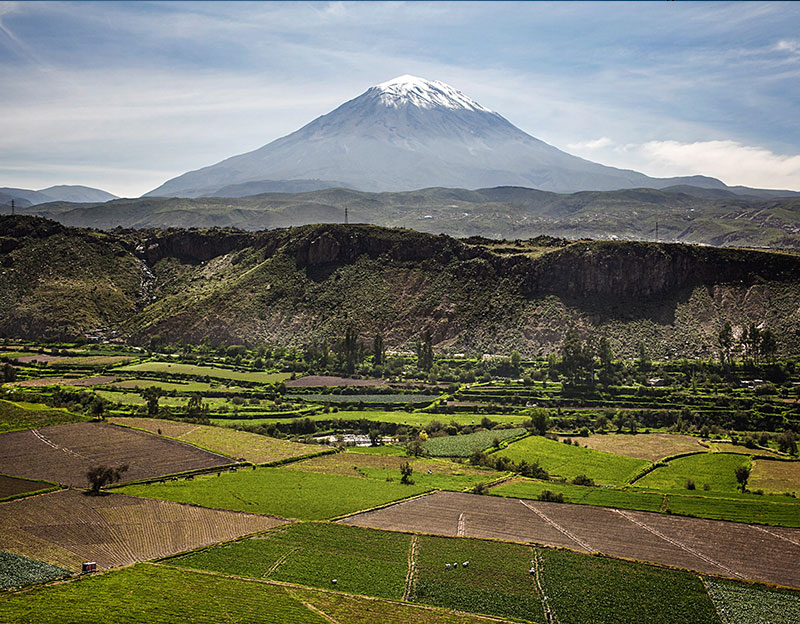
A trip to the countryside gives you a taste of what life was like for Arequipa’s colonial elite. On top of their casonas inside the city, wealthy families also built luxurious country residences in the surrounding valleys. Journey 20 minutes outside of Arequipa to visit Molino de Sabandia, a meticulously preserved water mill. Another key site is La Mansion del Fundador, an estate once owned by Arequipa\'s founder Garcí Manuel de Carvajal.

One of the region\'s hidden gems, the National Reserve encompasses a diverse range of natural environments. Experience wetlands, desert-like plains, expansive grasslands, and salt flats within. You can also expect to glimpse a range of camelids and flamingos.
The journey from Arequipa to Colca Canyon will take you through the Salinas and Aguada Blanca National Reserve. Tours departing from Arequipa head northeast through the reserve, with a stop at Pampa Cañahuas. Here, visitors can observe wild vicuñas and enjoy vistas of the Misti and Chachani volcanoes.

Tap into your sense of adventure and escape the city for Colca. A 3-hour drive from Arequipa, the world\'s second deepest canyon boasts soaring peaks and bottomless valleys. A highlight of any trip is a visit to the Cruz del Condor viewing platform. Here, cflex flex-wrap -mx-4ds gather to glimpse majestic Andean Condors in flight. There is also plenty of opportunity for relaxation at one of Colca\'s many hot springs. Take a look at our preferred Colca Canyon hotels.

Slicing 11,003 ft (3,354 m) into the ground, Cotahuasi is the world\'s deepest canyon. While nearby Colca Canyon steals much of the limelight, Cotahuasi offers striking landscapes. The plunging ravine stretches for 63 miles (100 km) and lies in the shadow of the Coropuna and Solimana peaks. Trekking opportunities are plentiful, and many rural communities remain untouched by tourists.
Lying 125 miles (200 km) northwest of Arequipa, Cotahuasi takes some effort to reach. But adventurers who make the journey will be rewarded with an unrivaled experience.
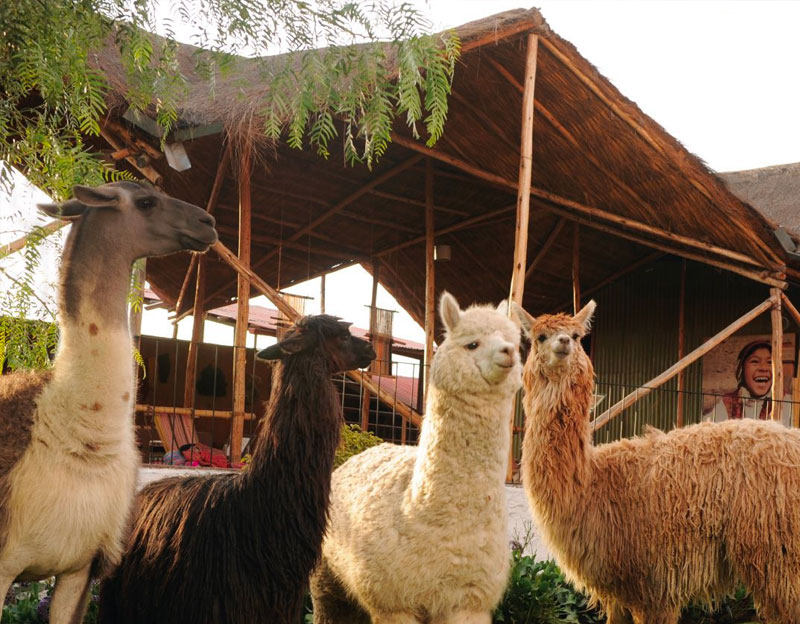
Spend a day with Peru\'s most famous inhabitants at Mundo Alpaca. Not only will you interact with adorable adult and baby alpacas, but you will also learn about their wool. Enjoy live demonstrations of age-old shearing, weaving, and dyeing processes. To finish up, visit the onsite textile museum and art gallery and bflex flex-wrap -mx-4se woven goods at the boutique outlet.

It is possible to organize eco tours in the Arequipa region. Activities include environmentally conscious excursions of varying lengths to Colca Canyon. Another option for adventurers is white water rafting on the Chili River.
During February and March Arequipeños celebrate the vibrant festival of Carnaval. Revelers from all over Peru flock to various events in the city. Visitors marvel at the brightly adorned dancers and colorful parades that march through the streets. Participants from various neighborhoods and villages create their own floats, each one representing a unique folkloric tradition.
One particularly famous event is Caperos, a party that takes place in the beach town of Mejía. Families from all over Arequipa attend, and different generations celebrate together. Party-goers wear playful costumes and enjoy throwing colorful powders at one another. Tourists are always welcome to join in this celebration of Arequipa\'s distinct history and culture.
Celebrated on August 15th, the Aniversario de Arequipa commemorates the re-founding of the city by Spanish settlers in 1540. In the fortnight preceding the anniversary, locals participate in traditional dances, beauty pageants, and climbing competitions on Misti volcano. The highlight of the celebrations is the annual fireworks show, which takes place on the 14th. Crowds gather in the stunning Plaza de Armas to wonder at the colorful illuminations.
In May, pilgrims from all over Peru and the continent travel to the town of Chapi in Arequipa Province. They gather to sing, chant, and pray to the Virgin of Purification. The most devout walk 28 miles (45 km) from Arequipa city to Chapi barefoot, carrying candles and walking staff. The following day the Virgin is born aloft through the streets of Chapi. Locals shower her with flower petals and later enjoy a spectacular firework display.
Hotels in Arequipa offer a mix of charming colonial architecture and modern facilities. Expect white sillar facades, rooftop terraces, and king size beds. Located close to the historic center, our top picks provide the perfect base to explore the city from.
To sample traditional Arequipa food, head to a picantería restaurant where you can select from 2 or 3 dishes. Bring your appetite as serving sizes are generous. Be aware that the word picantería derives from the Spanish word “picante,” meaning “spicy.” A little heat is a key characteristic of Arequipa cooking! Besides traditional restaurants, you’ll also find stand out international and fusion cuisine.
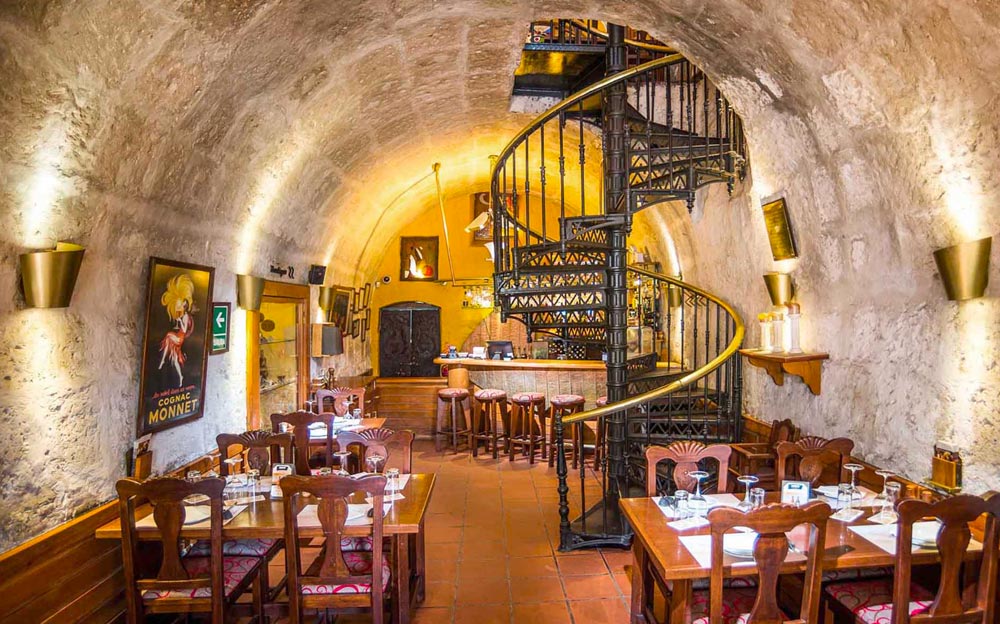
You can easily explore the historic center of Arequipa by foot. For longer distances, such as to the miradores or countryside, your Travel Advisor can arrange transfers in advance. You can also ask your hotel concierge to arrange transfers for you. For your own safety and peace of mind, do not hail a taxi from the street.
In Arequipa, the same advice holds true as it does for any new city you visit.
Keep valuables at your hotel. Stow money under your clothes in a zippered container and wear backpacks on your front when in crowded areas. Common sense goes a long way to avoid potential incidents, like petty theft. In the historic center, you will see a visible police presence. Don’t hesitate to let them know if you need assistance.
ATMs and casas de cambio (currency exchange offices) are available on the Plaza de Armas and surrounding streets. If withdrawing money from an ATM, it’s best to use a machine that is attached to a bank. Some machines will give you the option to withdraw in Soles (the local currency) or US dollars.
A few hotels, restaurants, and expensive shops in Arequipa accept credit cards. Be aware that many others don’t. For purchases in small amounts, it is best to pay in cash. Bear in mind that many smaller establishments may not have change for large bills. Try to reserve smaller bills and coins to spend in these instances. Keep note of emergency numbers for all credit or debit cards in case of loss or theft.
Arequipa is located on the popular southern route through Peru.
Many travelers choose the overland route from Arequipa to Colca Canyon and onward to Lake Titicaca (or vice versa). This allows them an extended look at truly breathtaking Andean landscapes. The journey can be made by bus, and often includes a tour of historical sites along the way.
Peru Rail has a great option geared toward high-end travelers: the Andean Explorer luxury sleeper train. This route connects Arequipa, Lake Titicaca, and Cusco. Inquire for details.
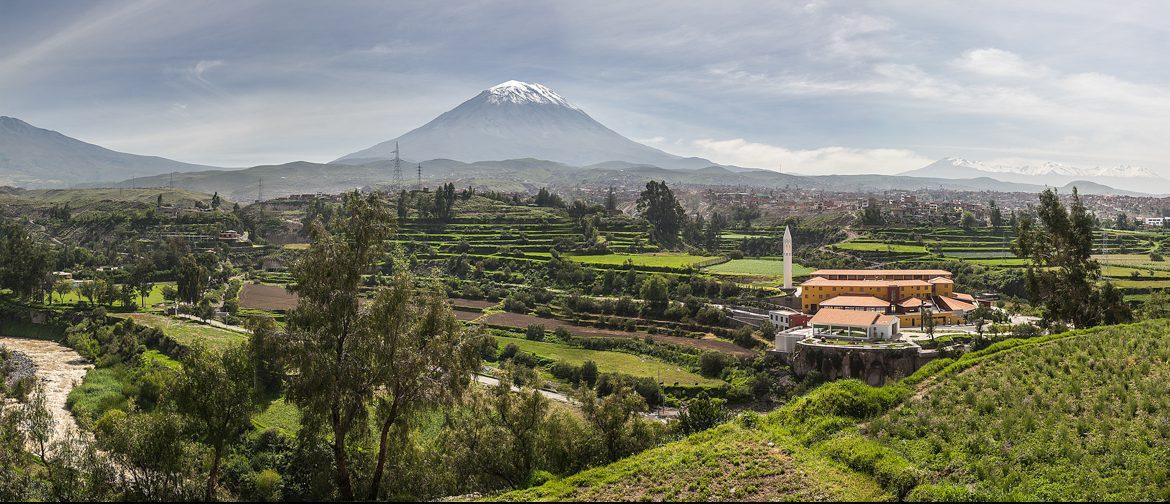
Arequipa is a true traveler’s paradise. Cobblestoned streets, fairytale architecture, and the looming presence of Misti Volcano all make for fantastic photographs.